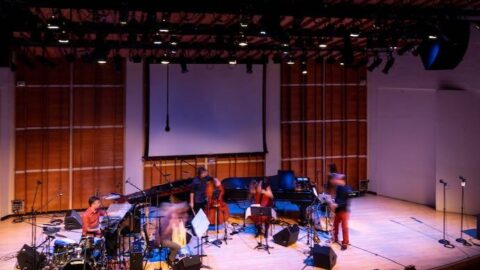On January 28, 2020, the Ecstatic Music Festival continued it’s 10-year run at the Kaufman Music Center with the annual Bang on a Can People’s Commissioning Fund concert, an annual performance of world premieres by adventurous composers commissioned by audiences from around the world. The Bang on a Can All-Stars took the form of an amplified sextet (or septet if you include their ever-important sound engineer), and performed works written with a simple prompt: create dance music. The performance was also co-presented and recorded for WNYC’s New Sounds Live. After WNYC nearly cancelled the show this past fall, only to reverse the decision after public outcry, host John Schaefer was welcomed to the stage with thunderous applause from the loving audience.
Qasim Naqvi described his piece Featureless as “inspired by the idea of a human form moving through a neutron star: the collapsed core of a giant star.” The dovetailing of melodies into one another represented the idea that the “bending of space time would break the body down into a trail of atomic light,” which was heard in clean, staccato guitar tones that melded with minimalistic lines in the clarinet and marimba. Each instrument carried its own version of the melody to the other, a metaphorical vortex of lines and ensemble sound. Amanda Berlind’s multimedia piece Bird Chart celebrated the “certain type of choreography” of birds, both musically and on screen. The manic illustrations of various birds (also created by Berlind) and live-action birds flitting around the screen gave a welcome felicity that’s come to define some of the Ecstatic Music Festival concerts. Bird Chart bounced rhythmically through the ensemble, which featured a full drum kit and literal “tweet” sounds, cued up from the sound booth.

The lone commissioned composer who was unable to attend was Icelandic composer Hildur Guðnadóttir, a newly minted GRAMMY award winner. Her piece Illimani (a document of the stream of notes in my head whilst moving) encapsulated the feeling of solemnity, which you’d expect from the composer of scores like Joker and Chernobyl. Long, somber themes weaved through the ensemble with percussive extended techniques in the prepared piano and malleted guitar. Shakers, toms, and choked-off piano notes drive the piece with a repeated ostinato that helps propel things forward. The meandering melodies felt consistent with Guðnadóttir’s description of them: “The closest thing to any type of dance I experience nowadays is the constant stream of melodies that just go on and on and on in my head as soon as I start moving.”
Alvin Curran’s Missteps (about 5 of them) was one of the more raucous performances of the night, with clapping, stomping, and a laptop full of sounds sprinkled in. A schmaltzy dance band style complete with brushed jazz drumming abruptly transitioned to a soprano saxophone Bop feel that slowly unraveled back to solo drumset, while another section followed the theme traveling one note at a time through each instrument. Pieced together in retrospect, the feeling of traveling through different musical eras was entertaining and satisfying as a whole.

Phil Kline’s Exquisite Corpses paints a scene of dancing ghosts inspired by the “echoes of the city,” which he envisioned as centuries of people all living together, mixing it up, dancing. Boomboxes accompanied the ensemble, starting slow and ethereal and eventually beginning to groove. Blue notes and driving crescendos gave the group a downtown rock feel, which was fully blown out by the drums, which were unfortunately placed high on stage and drowned out much of the ensemble. Perhaps metaphorically at least, this was useful as a way to demarcate the different sections between classical/minimalistic influences and rock, though hearing the full extent of the polyrhythms in the ensemble more in concert with the percussion may have felt more satisfying in the end.
To finish the night, the Bang on a Can All-Stars performed a meticulously researched and recreated version of Julius Eastman’s Stay On It. Eastman’s style of composition is more performance-based and improvisatory in nature and often lacks a full score, much less a partial score. Eastman’s personal journey complicates things further, as struggles with addiction eventually led to homelessness. His music, infectious with bravado and inventiveness, is well worth excavating, and he’s become something of a cult figure due to his works as well as his pioneering work of performance art, gay activism, and civil rights advocacy.
Though saddled with the existential question of “what is it?”, the Bang on a Can All-Stars performed Stay on It with verve and impressively captured the spirit of Eastman’s music. Tension slowly built and released with the musicians shouting “stay on it!” as they passed the melody onto the next. Frantic patterns and ever-evolving registers were used to evolve the theme, which, at one point, was taken over by the guitar playing with a whammy bar. The ensemble broke apart and reformed as squiggles of madness that, while seeming lost for a moment, ultimately found each other in the fray. Ending quietly, a solo tambourine meditatively repeated a pattern for a full minute before releasing the audience.
























